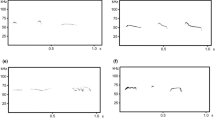Abstract
Signaling behaviors appearing in grooming interactions of wild Japanese monkeys were analysed. Vocal signals found in the grooming interactions had the content of asking the objective animal “if the vocal signaler may groom the recipient animal.” They could be divided into two categories of vocal sounds, VG-1 and VG-2. The former was uttered in common by all the troop members. The latter was uttered just before grooming by the groomer and is considered to have deeper connection with grooming. Each individual uttered mainly one kind of vocal sound out of VG-2, and the preferred vocal sounds for each individual differed. Furthermore, VG-2 differed in different troops. Behavioral signals had the content of showing “the acceptance of grooming” or showing “the request to be groomed.” The appearance of these signaling behaviors was closely related to the inter-individual relationships of grooming partners, especially as to whether or not they had blood relationships. Basically the monkeys have a system in which they must avoid each other, except in the case of mothers and their offspring, and if they had to approach too closely against this basic system, as in grooming interactions, there appeared signaling behaviors as mentioned above.
Similar content being viewed by others
References
Altmann, S. A., 1965. Sociobiology of rhesus monkeys: Stochastics of social communication.J. Theoret. Biol., 8: 490–522.
————, 1967. The structure of primate social communication. In:Social Communication among Primates,S. A. Altmann (ed.), Univ. of Chicago Press, Chicago, pp. 325–362.
Barnett, S. A., 1967.Instinct and Intelligence: The Science of Behavior in Animal and Man. MacGibon & Kee, London
Gardner, B. &R. A. Gardner, 1971. Two-way communication with an infant chimpanzee. In:Behavior of Non-human Primates,A. Schrier &F. Stollnitz (eds.), Academic Press, New York & London, pp. 117–184.
Hall, K. R. L., 1968. Social learning in monkeys. In:Primates: Studies in Adaptation and Variability,P. Jay (ed.), Holt, Rinehart, & Winston, New York, pp. 383–397.
———— &I. DeVore, 1965. Baboon social behavior. In:Primate Behavior: Field Studies of Monkeys and Apes,I. DeVore (ed.), Holt, Rinehart, & Winston, New York, pp. 53–110.
Hewes, G. W., 1973. Primate communication and the gestural origin of language.Curr. Anthrop., 14(1–2): 5–24.
Hockett, C. F., 1960. Logical considerations in the study of animal communication. In:Animal Sounds and Communication,W. E. Lanyon &W. T. Tavolga (ed.), American Institute of Biological Sciences, Washington, pp. 392–430.
Itani, J., 1963. Vocal communication of the wild Japanese monkeys.Primates, 4: 11–66.
Kawabe, S., 1965. Onsei no hattatsu (Vocalization and vocal communication of Japanese macaque babies raised in isolation).Kagaku-Yomiuri, 17(6): 21–25. (in Japanese)
Kawamura, S., 1958. The matriarchal social order in the Minoo-B troop: A study on the rank system of Japanese macaque.Primates, 1: 149–156. (in Japanese)
Koyama, N., 1967. On dominance rank and kinship of a wild Japanese monkey troop in Arashiyama.Primates, 8: 189–216.
Lancaster, J. B., 1968. Primate communication system and the emergence of human language. In:Primates: Studies in Adaptation and Variability,P. Jay (ed.), Holt, Rinehart, & Winston, New York, pp. 439–457.
Marler, P., 1965. Communication in monkeys and apes. In:Primate Behavior: Field Studies of Monkeys and Apes,I. DeVore (ed.), Holt, Rinehart, & Winston, New York, pp. 544–584.
Mori, A., in prep. Intratroop spacing mechanism of the wild Japanese monkeys of the Koshima troop.
Rowell, T. E., 1962. Vocal communication by rhesus monkey (Macaca mulatta).Proc. zool. Soc. Lond., 138: 279–294.
Takeda, R., 1965. Development of vocal communication in man-raised Japanese monkeys I.Primates, 6: 337–380.
————, 1966. Development of vocal communication in man-raised Japanese monkeys II.Primates, 7: 73–116.
Tokuda, K., 1965. Nihonzaru ni okeru kigo-teki kodo (Some signaling behavior of the Japanese monkey: A study of the development of grooming behavior). In:Saru (Monkeys and Apes),S. Kawamura &J. Itani (eds.), Chuokoron-sha, Tokyo, pp. 359–373. (in Japanese)
Yamada, M., 1963. A study of blood-relationship in the natural society of the Japanese macaque.Primates, 4: 43–65.
Author information
Authors and Affiliations
About this article
Cite this article
Mori, A. Signals found in the grooming interactions of wild Japanese monkeys of the koshima troop. Primates 16, 107–140 (1975). https://doi.org/10.1007/BF02381412
Received:
Accepted:
Issue Date:
DOI: https://doi.org/10.1007/BF02381412




